Ngā hononga hauora rite tahi
Health equity links
Examples of strategies helping address inequities in the Aotearoa New Zealand health sector.
Ngā hononga hauora rite tahi
Examples of strategies helping address inequities in the Aotearoa New Zealand health sector.
Health depends on many things, and ‘equal’ health is hard to achieve. Health providers try to provide quality services to all people in their care. However, factors such as age, poverty (deprivation), ethnicity, housing, health care service designs and government policies can all influence health.
There are a number of strategies in place to help address inequities in the Aotearoa New Zealand health and disability sector; the main ones are listed below.
![[decorative]](/assets/Uploads/Kumara-plain-tile__ResizedImageWzIzNywxMjZd.png) This equity scorecard was developed by Te Tāhū Hauora as a tool to support you in your learning and help identify areas that might need more work or reflection to enable you to deliver on equity and comply with the principles of Te Tiriti o Waitangi. It is intended to encourage critical self-reflection about your approach to embedding and/or enacting Te Tiriti o Waitangi in a specific project with a targeted equity priority community as well as in your wider work.
This equity scorecard was developed by Te Tāhū Hauora as a tool to support you in your learning and help identify areas that might need more work or reflection to enable you to deliver on equity and comply with the principles of Te Tiriti o Waitangi. It is intended to encourage critical self-reflection about your approach to embedding and/or enacting Te Tiriti o Waitangi in a specific project with a targeted equity priority community as well as in your wider work.
 Whakamaua: Māori Health Action Plan 2020–2025 is the implementation plan for He Korowai Oranga, Aotearoa New Zealand’s Māori Health Strategy. It will help us achieve better health outcomes for Māori by setting the government’s direction for Māori health advancement over the next five years.
Whakamaua: Māori Health Action Plan 2020–2025 is the implementation plan for He Korowai Oranga, Aotearoa New Zealand’s Māori Health Strategy. It will help us achieve better health outcomes for Māori by setting the government’s direction for Māori health advancement over the next five years.
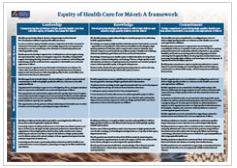 Equity of Health Care for Māori: A framework guides the Aotearoa New Zealand health sector on key actions that can be taken by the health system (such as the Ministry of Health, PHARMAC and regulatory authorities); health organisations (such as health districts, primary health organisations and other health providers) and health practitioners (such as doctors, nurses and community health workers) to achieve equitable health care for Māori.
Equity of Health Care for Māori: A framework guides the Aotearoa New Zealand health sector on key actions that can be taken by the health system (such as the Ministry of Health, PHARMAC and regulatory authorities); health organisations (such as health districts, primary health organisations and other health providers) and health practitioners (such as doctors, nurses and community health workers) to achieve equitable health care for Māori.
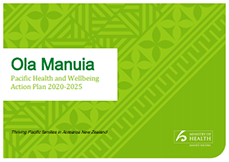 Ola Manuia: Pacific Health and Wellbeing Action Plan 2020–2025 was developed with input from Pacific communities, the health sector and relevant government agencies to provide a new direction for Pacific health and to improve Pacific health and wellbeing. This plan builds on the successes of ‘Ala Mo’ui: Pathways to Pacific Health and Wellbeing 2014–2018’ (Ministry of Health 2014).
Ola Manuia: Pacific Health and Wellbeing Action Plan 2020–2025 was developed with input from Pacific communities, the health sector and relevant government agencies to provide a new direction for Pacific health and to improve Pacific health and wellbeing. This plan builds on the successes of ‘Ala Mo’ui: Pathways to Pacific Health and Wellbeing 2014–2018’ (Ministry of Health 2014).
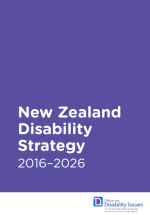 The 2001 strategy was developed in partnership with disabled people and their representative organisations and revised in 2016. The aim was to eliminate barriers to enable disabled people to reach their potential and participate fully in the community.
The 2001 strategy was developed in partnership with disabled people and their representative organisations and revised in 2016. The aim was to eliminate barriers to enable disabled people to reach their potential and participate fully in the community.
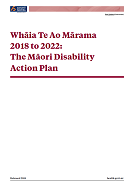 Whāia Te Ao Mārama is a culturally anchored approach to supporting Māori with disabilities (tāngata whaikaha) and their whānau because Māori are more likely to be disabled than are the general population. Most tāngata whaikaha identify as Māori first, so access to te ao Māori (the Māori world) is important to them.
Whāia Te Ao Mārama is a culturally anchored approach to supporting Māori with disabilities (tāngata whaikaha) and their whānau because Māori are more likely to be disabled than are the general population. Most tāngata whaikaha identify as Māori first, so access to te ao Māori (the Māori world) is important to them.
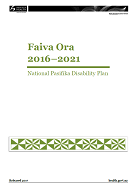 Faiva Ora sets out priority outcomes and actions that will contribute to achieving its vision:|
Faiva Ora sets out priority outcomes and actions that will contribute to achieving its vision:|
Pasifika disabled people and their families are supported to live the lives they choose.
 The CRPD and its Optional Protocol was adopted in December 2006 at the UN headquarters in New York. The Convention follows decades of work by the UN to change attitudes and approaches to persons with disabilities. It takes to a new height the movement from viewing persons with disabilities as ‘objects’ of charity, medical treatment and social protection towards viewing them as ‘subjects’ with rights who are capable of claiming those rights and making decisions for their lives based on their free and informed consent as well as being active members of society.
The CRPD and its Optional Protocol was adopted in December 2006 at the UN headquarters in New York. The Convention follows decades of work by the UN to change attitudes and approaches to persons with disabilities. It takes to a new height the movement from viewing persons with disabilities as ‘objects’ of charity, medical treatment and social protection towards viewing them as ‘subjects’ with rights who are capable of claiming those rights and making decisions for their lives based on their free and informed consent as well as being active members of society.
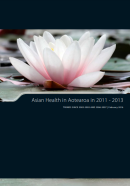 This report examines time trends in the health status of Asian participants interviewed in recent Aotearoa New Zealand health surveys, which recruit nationally representative samples of the resident Aotearoa New Zealand population. The large number of Asian participants in the combined 2011–12 and 2012–13 surveys has allowed analyses of the health status of the main Asian communities – South Asian, Chinese and other Asian – which have been compared with three other main ethnic groups: Māori, Pacific and European and other. Comparisons have also been made among South Asian, Chinese and other Asian participants between the three recent survey periods (2002–03, 2006–07 and 2011–13) to identify any trends among the Asian communities over this time.
This report examines time trends in the health status of Asian participants interviewed in recent Aotearoa New Zealand health surveys, which recruit nationally representative samples of the resident Aotearoa New Zealand population. The large number of Asian participants in the combined 2011–12 and 2012–13 surveys has allowed analyses of the health status of the main Asian communities – South Asian, Chinese and other Asian – which have been compared with three other main ethnic groups: Māori, Pacific and European and other. Comparisons have also been made among South Asian, Chinese and other Asian participants between the three recent survey periods (2002–03, 2006–07 and 2011–13) to identify any trends among the Asian communities over this time.
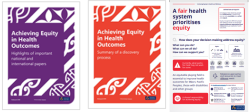
Having a common understanding of equity is an essential foundation for coordinated and collaborative effort to achieve equity in health and wellness. The Ministry of Health’s definition of equity can be used in all work and engagements within the health and disability system, including government agencies involved in the broader social and economic determinants of health, and can provide a common understanding of what is meant by equity.
The Ministry’s definition of equity is:
‘In Aotearoa New Zealand, people have differences in health that are not only avoidable but unfair and unjust. Equity recognises different people with different levels of advantage require different approaches and resources to get equitable health outcomes.’
The definition is designed to: